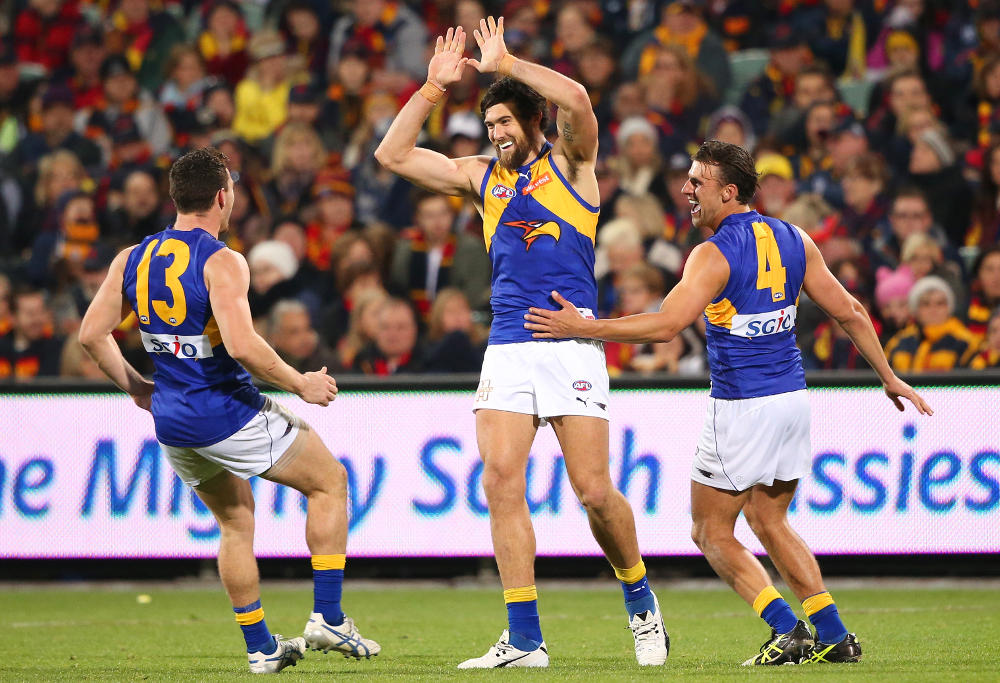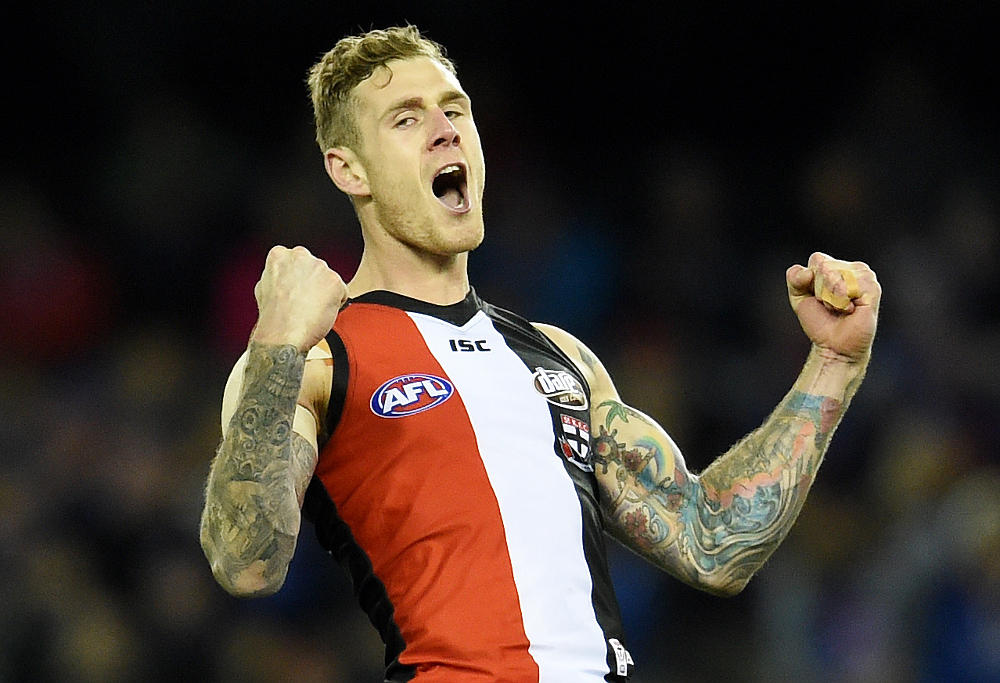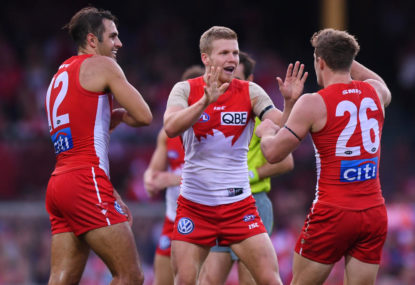In coming up with my AFL ladder prediction for 2017, I took into account three things.
One – that it’s still the pre-season, so it’s difficult to know which teams are slowly building loads and which teams are doing a Melbourne (going hell for leather in February!).
Two – this season is shaping up to be the tightest race for the top 8 since, well, last year. and
Three – there’s been so much hype about GWS dominating the competition for the next decade that it’s hard to go past them as minor premiers come the end of the home and away season. But that’s just what I’ve done.
Essentially it’s all a guessing game at this point – but here are my gut-feel predictions.
Ladder
1. Sydney
2. Western Bulldogs
3. Greater Western Sydney
4. West Coast
5. Hawthorn
6. Adelaide
7. St Kilda
8. Richmond
9. Collingwood
10. Geelong
11. Melbourne
12. Gold Coast
13. Port Adelaide
14. Essendon
15. North Melbourne
16. Fremantle
17. Carlton
18. Brisbane
Why Sydney?
Because not only have Sydney been one of the most consistent teams of the past decade, perpetually strong in the contest, with probably the deepest midfield in the game, but they also averaged close to 100 points a game in 2016, going some way to reversing the perception that the one thing holding back Sydney over the past couple of years has been their inability to be ruthlessly efficient going forward.
We saw that Sydney now have that quality in a bloodbath of a first quarter in their preliminary final victory against Geelong, kicking 7.2 to the Cats’ 0.5.
It was exhilarating football that was built on their midfield igniting from the opening bounce, a roaming Buddy Franklin dragging his usual tormentor Tom Lonergan further up the ground, removing Lonergan’s aerial prowess from Geelong’s defensive 50 which then looked significantly shakier in the blitz against the likes of Luke Parker (two goals in the first quarter), Isaac Heeney (1.0) and Ben Mcglynn (1.1).
The loss to the Bulldogs in the grand final the next week was more an indication that Sydney still have areas to improve and some holes to fill, than the last gasp of a group of also-rans.
The form of Isaac Heeney in the finals series, where he was finally unleashed as a goalkicking midfielder, is a hint of what might be to come this year. He seems primed for a big one.
Paired with 2016 rising star Callum Mills, an emerging Zak Jones and some young blood in the exciting Oliver Florent, the Swans are closer to the beginning of a successful period than the end of one.
Buddy will continue to be a force, their midfield will, amazingly, only get better as Heeney and possibly Mills are given more responsibility and Aliir Aliir could be an All-Australian defender in the next 2-3 years.
The development of the lesser lights in their forward line will be the question mark over Sydney. Can guys like Tom Papley, Gary Rohan and George Hewett continue to improve?
Will Kieren Jack be an effective small forward as he transitions from his previous midfield-centric role?
That’s the difference between another also-ran year and the possibility of a Swans premiership.

Give the Giants the flag already
Nobody can deny the quality of the Giants list. It actually hurts your brain to run your eyes over their list. Go to their website and try it, you’ll see what I mean.
No team could lose the young talent they’ve lost over the past 3-4 years and still be many people’s flag tip.
Except most of Caleb Marchbank, Jack Steele, Jarrod Pickett, Lachie Plowman, James Stewart, Jono O’Rourke et cetera were only fringe dwellers in the GWS team, plugging away in the NEAFL.
They are the AFL equivalent of a hydra, cut off one head (trade for said fringe dweller) and they get a top 20 draft pick which they use on either an academy player they’ve snuck up to Albury via Bacchus Marsh or they astutely pick up a kid like Rory Lobb at pick 29 that every other club overlooks.
But most predictions at this stage of the year are based on gut feel and I can’t escape the feeling that expectation and injuries to key personnel could best them this year.
Will they be able to handle the loss of Shane Mumford, Heath Shaw, Dylan Shiel and Jeremy Cameron if it happens at some stage?
We know the Bulldogs can handle these type of setbacks but evidence in previous years shows the GWS’s reliance on Mumford, in particular, has been too significant.
Are they now at a point in their development that the loss of their better players can be spread amongst others?
I’m not completely convinced but I also know that if they have the type of injury-free run Adelaide had last year, look out because their best is probably untouchable by another team this year.
Either way top 4 looks certain, they have too much young, elite talent and quality within their list depth to drop significantly even due to injury.
Sons of the West, still the best?
I have to admit I was slow to come around to the Bulldogs last year. There were just too many weaknesses, I thought.
When injuries continued to strike late in the year I finally wrote them off, as they had no real power forward, their defence was makeshift and they were too haphazard with their ball use at times.
Who could have guessed all these things would somehow become strengths by the last game of the year?
No power forward meant that they were highly unpredictable, while they at times appeared to waste inside 50 entries and needed to work overtime for every goal, their forwards continued to buzz around like drunken bees until things clicked come finals time and they overwhelmed the opposition defence.
We’re also starting to get an understanding of how their 18-man defensive zone, similar in method if not practice to the “Weagle’s Web” from 2015 and their chaotic ball movement worked so well come finals time.
Will the addition of a leaner looking Travis Cloke and the return of Stewart Crameri make the Bulldogs more predictable to the opposition?
Probably, but it also gives them weapons they didn’t have last year and under the direction of Luke Beveridge, anything is possible this year. A better run with injuries is certain because a worse one isn’t actually possible.

And the rest…
Here’s a summary of why I think the other teams will beat out the fierce competition from the teams below to finish in the top eight – but also a few weaknesses that may hold them back from challenging the above three teams for the flag.
4. West Coast
Strengths: Have possibly the best forward in the competition and the most prolific goal scorer in Josh J Kennedy.
Improvement still remains in Jack Darling, while Eric Mackenzie’s good form over the pre-season could allow Jeremy McGovern to spend more time forward.
Sam Mitchell is still a superstar and if their midfield becomes a little slow at times with he and Priddis in the engine room, moving Mitchell to half-back will allow his vision and skills to flourish and gives an extra dimension to the Eagles.
Weaknesses: Their backline lacks the run and carry off half-back of the best teams, Elliot Yeo needs to make the next step in his development to become a consistent threat and a young, silky small-forward or two would take their forward line to a new level. As it is Mark LeCras, Jamei Cripps and Josh Hill will do.
5. Hawthorn
Strengths: The best forward line in the competition (at least the most multi-dimensional). Just above GWS, though if Stevie J was younger I’d have a different view.
Jarryd Roughead, Jack Gunston, Luke Breust, Cyril Rioli, Paul Puopolo… Tyrone Vickery? His recruitment could pay dividends if he can contribute a goal or two a game plus take some of the load off a slow-looking Ben McEvoy.
The backline will remain as solid as ever though if Josh Gibson and Luke Hodge struggle this year, things could get tough back there.
Weaknesses: The ruck stocks are dwindling with Jon Ceglar likely out for the year while Ben McEvoy looks to be struggling to find his place in the Hawthorn team and in the modern world of rucking.
The midfield is an unknown quantity outside of Isaac Smith and the older bridge, as Liam Shiels needs to become more consistent and creative with the ball, star recruit Jaeger O’Meara has to stay on the park and Tom Mitchell to continue his improvement as a player and immediately assume some leadership in a transitioning midfield group.
Big years are needed from Will Langford, Jonathan O’Rourke, Billy Hartung and Kieran Lovell.
6. Adelaide
Strengths: A versatile, power-packed forward line with one of the two best small forwards in the game in Eddie Betts, though the forward group can go missing at times.
They have an even spread amongst the whole team with less reliance on a few star players than many other top eight contenders this year.
Weaknesses: The even spread amongst this group is great but for it to truly push for a premiership, it needs the likes of Jake Lever and the Crouch brothers to become elite, and guys like Andy Otten and Cam Ellis-Yolmen to take their opportunities.
If Charlie Cameron can become an A-grade small forward, then all guns will really be blazing in their forward line and anything is possible.

7. St Kilda
Strengths: There is a theme developing here. Most of the bottom half of this eight have dangerous forward lines but questions marks in a couple of other positions.
St Kilda have a modern forward set-up with neither Josh Bruce, Nick Riewoldt or Tim Membrey fitting the traditional mould of the power forward, but are still able to clunk contested marks while contributing at ground level and providing a target out of defence.
Weaknesses: The midfield still looks a few years away and a little way behind competing with the top end of my ladder, while their defence still relied heavily on aging players like Sean Dempster and Sam Fisher.
Jake Carlisle along with the reliable Nathan Brown could fix this issue, though Hugh Goddard should push past Nathan Brown this year barring injury.
8. Richmond
Strengths: One of the great modern defenders in Alex Rance, a much deeper looking midfield with the addition of Josh Caddy and Dion Prestia and Jack Riewoldt to hopefully be given the chance to show his abilities as a genuine game-breaking forward.
With Prestia, Caddy, Trent Cotchin, Anthony Miles and Dustin Martin as your starting midfield group, finals is a pass mark and anything less probably won’t end well for Damien Hardwick.
Weaknesses: An at-times turgid game style needs to go, while trying to use your best forward in Jack Riewoldt at times like a decoy for Ben Griffiths and Ty Vickery was hard to understand in 2016.
Daniel Rioli looks to be improving with every game he plays but the small/medium forward department at Richmond looks a little bare.
Finding a way to utilise the talent that Nick Vlastuin, Brandon Ellis and Reece Conca have will be important for Richmond’s improvement this year and into the future.
































































































